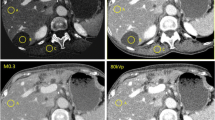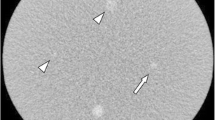Abstract
Objective
To assess image quality and diagnostic accuracy of monochromatic imaging from spectral CT in patients with small HCC (≤3 cm).
Methods
Twenty-seven patients with 31 HCC underwent spectral CT to generate conventional 140-kVp polychromatic images (group A) and monochromatic images with energy levels from 40 to 140 keV (group B) during the late arterial phase (LAP) and the portal venous phase (PVP). Two-sample t tests compared the tumour-to-liver contrast-to-noise ratio (CNR) and mean image noise. Lesion detection for LAP, reader confidence and readers’ subjective evaluations of image quality were recorded.
Results
Highest CNRs in group B were distributed at 40, 50 and 70 keV. Higher CNR values and lesion conspicuity scores (LCS) were obtained in group B than in group A (CNR 3.36 ± 2.07 vs. 1.47 ± 0.89 in LAP; 2.29 ± 2.26 vs. 1.58 ± 1.75 in PVP; LCS 2.82, 2.84, 2.63 and 2.53 at 40–70 keV, respectively, vs. 1.95) (P < 0.001). Lowest image noise for group B was at 70 keV, resulting in higher image quality than that in group A (4.70 vs. 4.07; P < 0.001).
Conclusion
Monochromatic energy levels of 40–70 keV can increase detectability in small HCC and this increase might not result in image quality degradation.
Key Points
• Spectral computed tomography may help the detection of small hepatocellular carcinoma.
• Monochromatic energy levels of 40–70 keV increase the sensitivity for detection.
• Prospective study showed that monochromatic imaging provides greater diagnostic confidence.
• Monochromatic energy level of 70 keV improves the overall image quality.




Similar content being viewed by others
Abbreviations
- LAP:
-
late arterial phase
- PVP:
-
portal venous phase
- CNR:
-
contrast-to-noise ratio
- kVp:
-
peak kilovoltage
- keV:
-
kiloelectron volts
- DECT:
-
Dual energy computed tomography
- mGy:
-
milligray
- CTDIvol:
-
volume computed tomography dose index
References
Baron RL, Oliver JH, Dodd GD, Nalesnik M, Holbert BL, Carr B (1996) Hepatocellular carcinoma: evaluation with biphasic, contrast-enhanced, helical CT. Radiology 199:505–511
Yaqoob J, Bari V, Usman MU, Munir K, Mosharaf F, Akhtar W (2004) The evaluation of hepatocellular carcinoma with biphasic contrast enhanced helical CT scan. J Pak Med Assoc 54:123–127
Lim JH, Choi D, Kim SH et al (2002) Detection of hepatocellular carcinoma: value of adding delayed phase imaging to dual-phase helical CT. AJR Am J Roentgenol 179:67–73
Okuda K (1992) Hepatocellular carcinoma: recent progress. Hepatology 15:948–963
Yoshikawa J, Matsui O, Takashima T et al (1988) Fatty metamorphosis in hepatocellular carcinoma: radiologic features in 10 cases. AJR Am J Roentgenol 151:717–720
Martin J, Sentis M, Zidan A et al (1995) Fatty metamorphosis of hepatocellular carcinoma: detection with chemical shiftgradient-echo MR imaging. Radiology 195:125–130
Jeon TY, Kim SH, Lee WJ, Lim HK (2010) The value of gadobenate dimeglumine-enhanced hepatobiliary-phase MR imaging forthe differentiation of scirrhous hepatocellular carcinoma and cholangiocarcinoma with or without hepatocellular carcinoma. Abdom Imaging 35:337–345
Kudo M (2004) Atypical large well-differentiated hepatocellular carcinoma with benign nature: a new clinical entity. Intervirology 47:227–237
Schindera ST, Nelson RC, Mukundan S Jr et al (2008) Hypervascular liver tumors: low tube voltage, high tube current multi-detector row CT for enhanced detection–phantom study. Radiology 246:125–132
Altenbernd J, Heusner TA, Ringelstein A, Ladd SC, Forsting M, Antoch G (2011) Dual-energy-CT of hypervascular liver lesions in patients with HCC: investigation of image quality and sensitivity. Eur Radiol 21:738–743
Marin D, Nelson RC, Samei E et al (2009) Hypervascular liver tumors: low tube voltage, high tube current multidetector CT during late hepatic arterial phase for detection–initial clinical experience. Radiology 251:771–779
Huda W (2002) Dose and image quality in CT. Pediatr Radiol 32:709–713, discussion 751–754
Johnson TR, Krauss B, Sedlmair M et al (2007) Material differentiation by dual energy CT: initial experience. Eur Radiol 17:1510–1517
Zhao LQ, He W, Li JY, Chen JH, Wang KY, Tan L (2011) Improving image quality in portal venography with spectral CT imaging. Eur J Radiol. doi:10.1016/j.ejrad.2011.02.063
Lv P, Lin XZ, Li J, Li W, Chen K (2011) Differentiation of small hepatic hemangioma from small hepatocellular carcinoma: recently introduced spectral CT method. Radiology 259:720–729
Byun JH, Kim TK, Lee CW et al (2004) Arterioportal shunt: prevalence in small hemangiomas versus that in hepatocellular carcinomas 3 cm or smaller at two-phase helical CT. Radiology 232:354–360
Guimaraes LS, Fletcher JG, Harmsen WS et al (2010) Appropriate patient selection at abdominal dual-energy CT using 80 kV: relationship between patient size, image noise, and image quality. Radiology 257:732–742
Kukuk GM, Gieseke J, Weber S et al (2011) Focal liver lesions at 3.0 T: lesion detectability and image quality with T2-weighted imaging by using conventional and dual-source parallel radiofrequency transmission. Radiology 259:421–428
Landis JR, Koch GG (1977) The measurement of observer agreement for categorical data. Biometrics 33:159–174
Brooks RA (1977) A quantitative theory of the Hounsfield unit and its application to dual energy scanning. J Comput Assist Tomogr 1:487–493
Yeh BM, Shepherd JA, Wang ZJ, Teh HS, Hartman RP, Prevrhal S (2009) Dual-energy and low-kVp CT in the abdomen. AJR Am J Roentgenol 193:47–54
Acknowledgement
The authors wish to thank Dr. Jianying Li for his technical support in understanding the dual-energy spectral CT imaging mode.
Author information
Authors and Affiliations
Corresponding author
Rights and permissions
About this article
Cite this article
Lv, P., Lin, X.Z., Chen, K. et al. Spectral CT in patients with small HCC: investigation of image quality and diagnostic accuracy. Eur Radiol 22, 2117–2124 (2012). https://doi.org/10.1007/s00330-012-2485-3
Received:
Revised:
Accepted:
Published:
Issue Date:
DOI: https://doi.org/10.1007/s00330-012-2485-3




